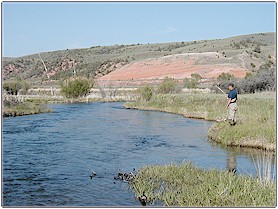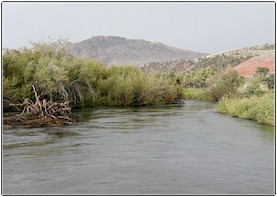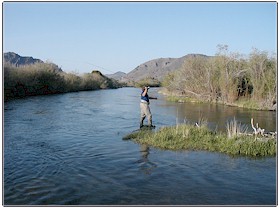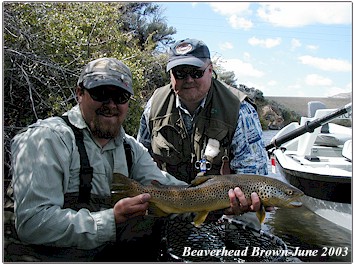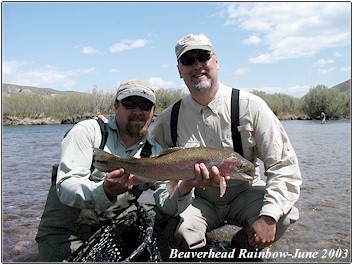| |
 |
|
|
| Upon our
return from Southwestern Montana, we arrive home to the Yakima River Valley to find
dry, hot weather. With the increase in heat over Central Washington, high
mountain snows are melting fast, filling the storage reservoir holding
facility of Cle Elum, which lies just below the east slope of the Cascade
Mountain Range. As warm weather continues, B.O.R. officials are
discharging water as quickly as it is entering the reservoir. |
|
|
Unfortunately, a mass of warm air had also been hovering over the "Big
Sky Country" just a couple of days before our departure on May 30th to
host a 3 day
guided fly fishing adventure to Southwest Montana. The
heat was taking its toll on the late snow pack western Montana had received
and the majority of free-flowing rivers were pushing hard at their banks.
As we entered Montana, descending over Look Out Pass, the St. Regis River
was moving swift towards its destination with the Clark Fork at the small
town of St. Regis. At the confluence of these two rivers, dark murky
waters were converging. White water enthusiasts loaded with rafts and
kayaks were the only ones excited about river conditions as they made their
way to the Alberton Gorge. |
|
|
"Significance" |
|
|
Camp Fortunate (Clark Canyon) |
|
Captain Lewis found a camp of Shoshone
Indians and gained acceptance of the tribe, as Sacagawea had
recognized the Shoshone chief, Cameahwait, as her brother. The
Expedition stayed for several days with the Shoshones and traded for
horses at the site that is now inundated by Clark Canyon Reservoir.
On the Lewis and Clark expedition, Sacagawea recognized this as a
landmark of her people because of the resemblance of the rock to a
beaver's head. |
|
The Big Hole, Jefferson and Ruby Rivers, as
well as other area streams had finally crested on our final day of fishing and
began
to recede. The Big Hole had reached a flow of over 9500 cfs.
(cubic feet per second) before
finally starting to settle. It was unfortunate for us, but one can never truly predict the
contemplation of Mother Nature.
|
|
However, the trip was far from a wash. We spent our 4 days
floating and fishing the "Beaverhead River" southeast of the city of Dillon.
This didn't bother the six of us at all. Water conditions were excellent every day.
The weather was warm and sunny and
most importantly the fish were eating!
The headwaters of the Beaverhead River originates at the west end of the
"Clark
Canyon Reservoir"
which was erected in 1964 as a water holding facility for farming
and irrigation needs.
The reservoir encompasses over 6000 acres and is a popular spot for
fishing throughout the year. Clark Canyon is filled each year by
annual snow pack from Upper Red Rock Creek. The Lower Red Rock river
flows from the east end of the reservoir. |
 |
| |
 Looking West In The Middle Of Clark Canyon Dam
Looking West In The Middle Of Clark Canyon Dam
|
|
|
|
|
|
| The lake is home to
some of the state's largest rainbow and brown trout populations. The
reservoir is referred to as the "trout farm" by local residents. Here,
the trout grow to large sizes feeding easily on an abundance of aquatic
forms. Early spring rainbows will leave the reservoir and move into
the Beaverhead River in search of spawning grounds. When Fall arrives,
the large brown trout will undertake the same journey. Once they have
reached the river, there is no return to the reservoir. They are now
resident Beaverhead fish. |
|
|
|
"The Upper Drift"
dam to high bridge; |
| |
| Fish counts are
high, in fact the Beaverhead is believed to hold some of Montana's
largest resident rainbow and brown trout populations. With fish counts
well over 3000 per mile, one would think it would be like catching fish
in a barrel. Not so! |
|
|
Insect life below the dam at Clark Canyon is astounding. Wave
after wave of aquatic life filters through the water column on an hourly
basis. Through the first several miles of river, trout rarely move
far to feed as a variety of cuisine is constantly attracting their attention. Small nymphs, a fluorocarbon tippet with a flawless drift are perquisites for fishing
this section of water. During times of Caddis blooms, swinging
small, wet flies and soft hackles can be productive. |
|
| Aquatic nymphs such as Baetis, PMD's,
Caddis, Sow bugs, Scuds, Blood
worms, Midges, Yellow Sallies and Golden Stoneflies are all present in large numbers
throughout the system. This rich resource of nutrients is available
throughout most of the year. Hopper and Terrestrial fishing will
become important later this month and last well into the first parts of
September. |
|
|
Launching a drift boat below the dam is the
first part of the daily adventure. It's primitive, it's Montana.
A steep, rocky embankment is the launch area. Once the boat is
wet, gear is loaded, fly rods are prepared with a special leader that will
sink your small nymphs fast and a strike indicator is applied.
This is big Rainbow water that is shared with its brethren, the Brown
Trout. This section of the river is popular for wading and shore
anglers. Access to both sides of the Beaverhead is easily obtainable by road.
The fish are everywhere, so each drift is shared with wading anglers and
drifters, however boat and river etiquette is practiced. Deep
slots with some fast riffles and runs primarily make up this section of
the Beaverhead. Some days can provide dry fly fishing,
however the abundance of nymphs is far greater and much easier for the
fish to
obtain. |
|
|
Wading anglers and boat anchors ring the
dinner bell for the "Dam" trout. Aquatic clingers are
kicked loose among the rocks and become forage for the Beaverhead's resident
fish populations.
Rainbows and Browns literally line up at your feet or below the boat waiting for this easy meal, kicked loose by wading boots
or dragging anchors. A variety of food sources is delivered
down stream. The feeding is effortless with no potential for
wasting precious energy reserves. |
|
|
Come prepared with flies. Your
going to lose a few on the Beaverhead, especially through this section
of river. If your not equipped there are several shops, staffed
with local experts throughout the
Dillon area that are well stocked and ready to help you. Tim Tollett operates
Dillon's oldest fly shop,
"Frontier Anglers" located just off the main
interstate into town. We found the guys at the
"Beaverhead Special" on the east hill above the reservoir to be
helpful. They are located right on the river as well and spend
most of their days
fishing. In fact, when we arrived at the shop, the first morning
the door was locked and a sign was posted on the door. "Honk if
you need flies! Gone Fishing". A couple of blasts from the
Chevy Suburban caught the attentions of fly shop owner, Brent Satterfeild
as he quickly hiked up the well beaten path from one of the popular wading holes of the Beaverhead. He
graciously opened the shop and we quickly began pillaging his fly
assortments. |
|
Local Fly-Shop Contact Information |
|
|
 |
Frontier Anglers-(406) 683-6811 |
| |
 |
Beaverhead Special-(406) 683-6811 |
| |
 |
Backcountry Angler-(406) 683-3462 |
| |
|
|
|
|
| "The Middle Drift" high
bridge to hennenberry; |
|
| Once you arrive at
"High Bridge,"
the gloves come off. This is brown trout water. Intensely thick
bank cover provides adequate safety and gives these aggressive feeders the shelter they
desire. Streamer fishing can
be very productive through this section of the Beaverhead. Deep ledges cut through the
river bottom, so nymph fishing still plays an active roll in your fishing
opportunities. Each day provided us with
something different, a variety of new and exciting challenges. The cloudy,
Cumulus days provided the adequate cover we needed for productive streamer
fishing. Incorrigible browns were coaxed by special techniques and could be moved from their hiding lair
during these times of the day. The Beaverhead is home to many sculpin and
crayfish. Smaller Burbot also inhabit the reservoir and are often thrust
into the river when dam releases are high. These small bottom feeders
become breakfast, lunch and dinner for the large browns of the Beaverhead.
Kyle's Egg-Head was by far our most productive streamer in both the olive
and tan. It is a excellent representation to entice and expose the
browns from the thick cover that abounds along the banks of this section of
the Beaverhead. |
|
| This area of the
river provides fast currents as well as a steep grade through most of the drift.
The river quickly begins to form channels with braids branching in every
direction. If you venture from the main stem, the river becomes narrow and will
provide many different areas to fish. While floating one of these
braids, an
encounter with a young bull moose
provided my partners and I with a memorable Montana wild life experience.
The young bull wasn't concerned about us, while feeding on the lush, green vegetation.
However, at one point he did let us know that he was definitely in charge of that area of the river.
We fished awhile and then moved on leaving him to gorge on the grasses of
the Beaverhead. |
|
|
|
|
|
| "The Bottom Drift"
hennenberry to grasshopper; |
|
| This section of
river provides a variety of fly fishing circumstances. Access can be
limited on foot and provide boating anglers an advantage over fish and feet.
The river continues to move swift, but also provides a set of long, deep,
slow moving pools. Another boat launch called "Pipe Organ" is down
stream just a short distance. This is perfect drift for those looking
for a quick fix of the Beaverhead or those limited on time. |
|
| Mouse patterns can
be fished tight along the grassy banks of this section during the months of
summer. We have experienced days when large browns lie in wait to
feast on small rodents. As a fly fishermen, this is one of the
fantastic factors that appeals to me about fishing the great waters of
Montana. Large browns become highly aggressive like a Smallmouth Bass
and at times are looking for this bigger, furry meal to fill their belly.
|
|
| Towards the end of
the drift, the river empties into a small, swift, rocky channel.
Banging the banks and small pockets behind rocks that are created, provided us
with some fast and furious streamer action. Grasshopper Creek
converges with the Beaverhead below this area of the river. During
times of run-off, this larger creek flowing from the Pioneer Mountain Range
deposits large amounts of water mixed with sand and silt. The river at
this point becomes dark, dirty and nearly impossible to fish productively.
Later in the summer flows will recede in Grasshopper, however farmers use
the creek to dump off field irrigation and some parts can remain dingy. |
|
|
| Despite high water
conditions throughout the state, the Beaverhead provided us with exceptional
fishing opportunities during our short visit. We are looking forward
to returning and have plans in the works now to host our 2nd trip to
Southwest Montana in August with Montana High Country Lodge. |
|
| During our last
evening in Dillon, a crowd of local fly fishing guides had gathered at the
local watering hole to celebrate the 27th birthday of our guide, Kyle Giampoli.
Central Washington hayseed, Luke Scarloa drunkenly called out to the crowd
"Which way is home ?" Tim Mostoff, the oldest and most
respected Beaverhead guide, also known as "Griz", stepped out of the
crowd and exclaimed "Left at Butte." As I laugh to myself, I thought this was
the perfect capper to the end of a great Montana trip. Of course,
Hayseed didn't know how to respond and the joke went over his head.
Maybe you had to be there or just know Tim's refined sense of humor. |
|
| If you plan to
travel to Montana to fish its many diversified waters, go with an open
mind. Be willing to try different patterns and techniques. You
may encounter one of the best fishing experiences of your life! |
|
|
|
 |
|
|
|
For more information on
our 2nd hosted guided trip to the "High Country Lodge" please contact us at
the Ellensburg pro-shop or email us at:
worleybugger@elltel.net |

